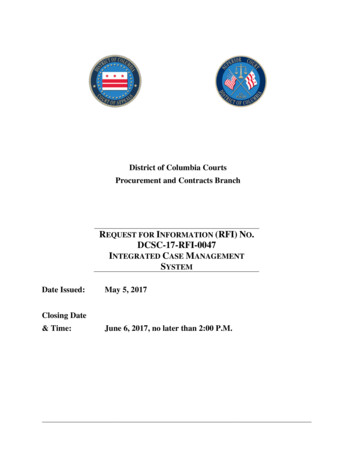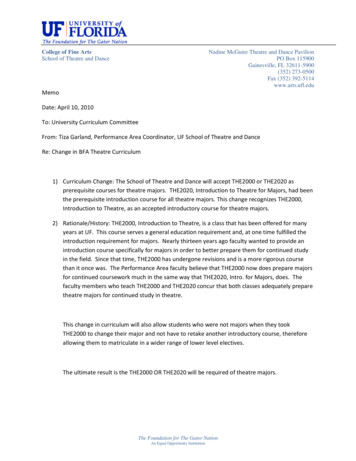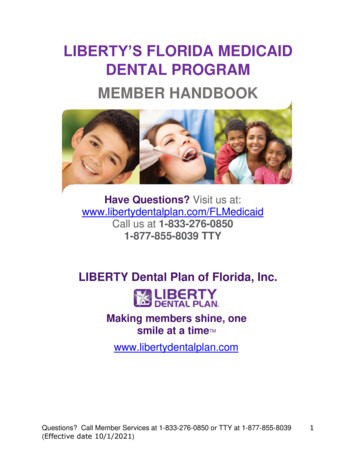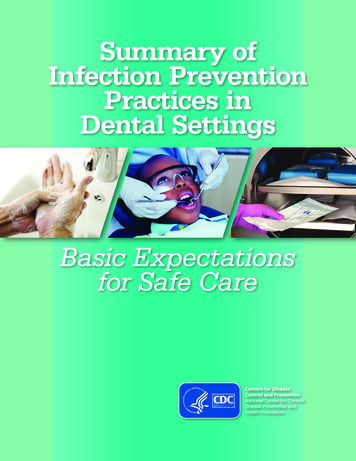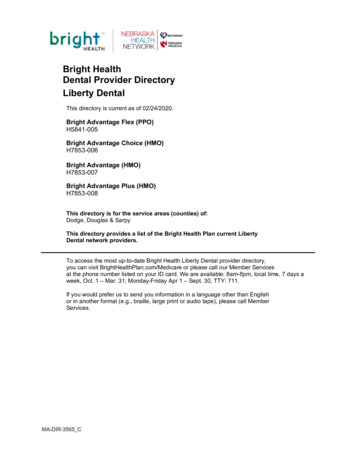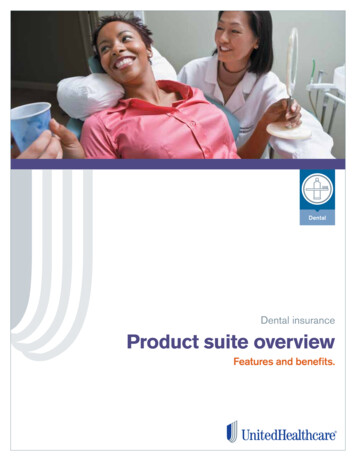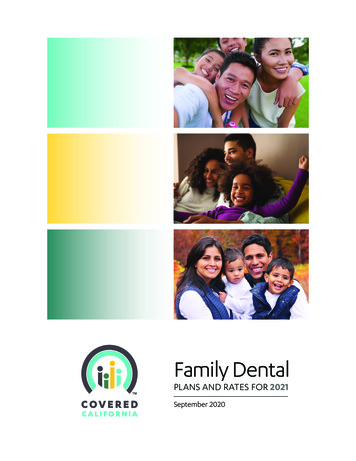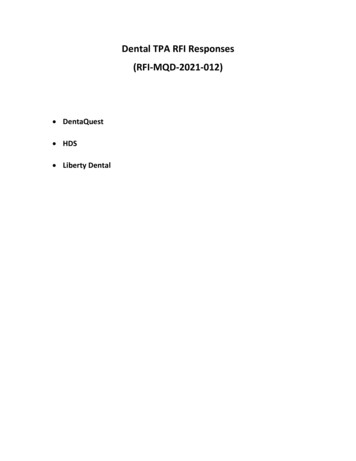
Transcription
Dental TPA RFI Responses(RFI-MQD-2021-012) DentaQuest HDS Liberty Dental
Response to Request For InformationNo. RFI-MQD-2021-012IntroductionDentaQuest appreciates the opportunity to respond to the Dental Third PartyAdministrator (TPA) Services for the State of Hawaii Medicaid Population, Request ForInformation No. RFI-MQD-2021-012.As the largest Medicaid dental benefit administrator (DBA)/dental managed careorganization (DMO) in the country serving nearly 23 million Medicaid recipients across21 states, DentaQuest respectfully offers its insights into industry trends, coupled withits firsthand experience (serving as a major subcontractor to Hawaii Dental Service forthe bulk of its operational functions from 2013 through 2015), to inform the Departmentof Human Services (DHS), Med-QUEST Division (MQD) on ways it could improve itsdental program.Like most states in the country, Hawaii and its residents have been hit hard by theCOVID-19 pandemic. States are simultaneously facing compressed budgets and higherMedicaid enrollment. We understand that Hawaii is facing an unprecedented budgetshortfall coupled with the highest rate of unemployment nationally.While the Medicaid dental benefit is one piece of the state’s overall Medicaid budget, weare confident that the ideas presented in this RFI response can yield meaningfulsavings, while increasing access to care. The ideas we present are not theoretical – wehave implemented them across several states successfully, and would welcome theopportunity to share more information with Hawaii, and/or conduct a deeper diveanalysis into your claims expenditures to quantify tangible savings available to Hawaii.Understanding and Defining the Three Core Dental Delivery ModelsBefore we delve into our recommendations, we believe it is important to define the threedental delivery models employed across the country at a macro level, as well asindustry trends across these models. The three models include: Carve in model: State carves dental benefit into its comprehensive risk-basedcontracts with managed care organizations.Carve out model: State creates a separate budget and program for its Medicaiddental benefit and contracts directly with DBAs or DMOs. This model has been usedin Hawaii since 2013.Fee for service model: State pays for and administers the dental benefit itself.Figure 1 on the next page delineates some of the key nuances between the models.1 Page
Response to Request For InformationNo. RFI-MQD-2021-012Figure 1: Different Medicaid dental delivery modelsFEE-FORDENTAL CARVE IN MODELSERVICEMODELDENTAL CARVE OUT MODEL40% of all states employ this modelASO carve outCapitated carve outPercentage ofstates using model27%33%Among states employing carveout – 48% use ASO modelAmong states employing carve out –52% use capitated modelDelivery systemdefinitionStateadministersits ownMedicaiddental inhouse usingagency staff.N/AThe Medicaid dental benefit iscarved out of the overall stateMedicaid budget. Theadministration of the program ishandled by a DBA (seedefinition below) that accepts aset per member per monthpayment to cover theadministrative services onlyexpenses of the program.Dental benefit administrator*: Inthe context of this model, a DBAis an organization that contractsdirectly with the state agency toadminister the carved out dentalbenefit. The DBA is notaccountable for managingclaims costs.The Medicaid dental benefit is carved outof the overall state Medicaid budget. Thestate contracts with a single or multipleDMO(s) (see definition below) thataccept a set per member per monthpayment covering the cost ofadministrative services, as well as claimscost (also referred to as the “financialrisk” or “cost of care” of a program).Key terminologyused within thismodelResponsible foradministeringdental benefitNumber oforganizationsmanaging dentalbenefitResponsible forclaims costsContracts with theprovider networkStateDental is included as part of the state’soverall Medicaid managed care program.Medicaid managed care provides for thedelivery of Medicaid health benefits andadditional services including dentalthrough contracted arrangementsbetween state Medicaid agencies andmanaged care organizations (MCOs)that accept a set per member per month(capitation) payment for these services.Managed care organization (MCO):Companies contracted directly with thestate to manage a comprehensiveMedicaid program.Dental benefit administrator (DBA): In thecontext of this model, a DBA is anorganization that an MCO maysubcontract with to administer the dentalportion of the managed care contract.MCO or DBADBADMOVaries by state. For example, in Arizonathree of the MCOs manage dental inhouse, and the other four subcontract toDentaQuest.MCO or DBA depending on contractterns between the two entities.MCO or DBA depending on contractterns between the two entities.OneOne to threeStateDMOPer state’s discretion could bestate or DBA.DMOOneStateStateDental managed care organization(DMO)*: A company that contractsdirectly with the state agency to providefor the delivery of Medicaid dentalbenefits.N/AASO or capitated between MCO An organization such as DentaQuest is both a dental benefit administrator and a dental managed care organization depending on what financial contractingarrangement they have with their clients. Many times, these terms are used interchangeably.2 Page
Response to Request For InformationNo. RFI-MQD-2021-012As noted in Figure 1, today, 40% of states provide their Medicaid dental benefitsthrough a dental carve out. Furthermore, in the last decade alone, 10 states havemoved to this model; four of which moved their dental program out of the state’s overallmanaged care program to a carve out model (Figure 2). In addition, the state ofOklahoma will be moving to a capitated dental carve out later this year.Dental Carve Outs: ASO vs. CapitationAs noted in Figure 1, within the dentalcarve out model, we can furtherdelineate between two program types:an ASO carve out versus a capitatedcarve out. Both of those models aredefined above. What’s important tonote here is that since 2010, 80% ofstates that have moved to a dentalcarve out model have done so using acapitated financial arrangement. Priorto 2010, it was the exact opposite –80% of states contracted with DBAsunder an ASO financial arrangement.Figure 2: States that moved to dental carve out in pastdecadeStateCarve outNumber of DBA/DMOsmodelmanaging dental carve ahCapitatedOklahomaCapitatedAward pending; go-live9/1/2021It’s important to recognize the evolutionof the dental carve out throughout the past two decades to fully understand why stateshave moved to the fully capitated structure.2000 – 2009: Focus on Administrative EfficienciesEarly state adapters of the dental carve out model wereDid You Know?focused on improving core administrative functions such asSince 2014, no stateclaims processing efficiencies, and increasing providerthat chose to move to aparticipation as a means to increase access to dental care.dental carve out hasSeveral states, such as Illinois, Tennessee, andselected the ASOMassachusetts were subject to class action lawsuits due tofinancial structure.non-compliance with EPSDT requirements specific todental care. The dental carve out model was widelyacknowledged as the approach that could help states address very complex challenges.Near the end of the decade, states became increasingly focused on efforts to improveoverall utilization of dental services.2010 – 2014: Focus on Triple AimAs the decade turned, so did the expectations of states. State agencies started lookingto their dental partner to strike the right balance between core administrative servicesand creative ways to improve quality and manage costs. It was the beginning stages ofa trend in which states focused on achieving the Triple Aim – the simultaneous pursuitof better health outcomes, reducing costs, and improving the patient experience.States began leveraging best practices from their Medicaid managed care programs tocreate similar program structures for their carved out dental programs. They beganviewing and treating their DBAs as managed care plans, and as such, shifted all of theprogram costs – both administrative and claims costs – to their dental partner. Thus the3 Page
Response to Request For InformationNo. RFI-MQD-2021-012idea of “dental managed care” came to be. Just as states do with their MCOs, theDMOs were expected to achieve the desired results within the set capitated rate.2015 – Today: Focus on Quadruple AimThis leads us to the most recent few years,where states have again evolved based onnew goals. Today the Quadruple Aim isbecoming a standard method by whichstates gauge the success and efficiency oftheir Medicaid dental programs.Additionally, the majority of statesimplementing a capitated carve out modeltoday are mirroring best practices in themanaged care programs – requirementsaround population health management,case management, integration withmedical, and value-based care, among others.The bottom line: The Medicaid dental carve out model using a fully capitatedarrangement has emerged as the dominant model.One again, we appreciate this opportunity to share information with DHS. Should DHShave additional questions, please reach out to our Vice President of Government SalesLawless Barrientos at Lawless.Barrientos@dentaquest.com or 303.877.0929.4 Page
Response to Request For InformationNo. RFI-MQD-2021-0121. What recommendations can you make to the DHS about how best to administerdental benefits to our eligible Medicaid beneficiaries? Are there any specialconsiderations that should be taken into account and included in this RFP?DentaQuest respectfully offers the following recommendations: Transition from an ASO arrangement to a fully capitated arrangement (see ourresponse to #5 for more detail) to establish greater accountability for the DMO,better cost predictability, and lower overall program costs.We encourage the state to add contractual goals related to operational efficienciesfor Medicaid dental programs. This would include, but not limited to: claimsprocessing; utilization management; customer service; complaints and grievances;fraud, waste and abuse prevention and detection; reporting; etc.Most dentists are apprehensive about signing contracts or LOIs with bidders duringa procurement process. Therefore, we recommend DHS not require signedcontracts or LOIs during the RFP, and instead, score bidders based on their plans tobuild a network. To ensure the network complies, DHS should review and validatenetwork adequacy during the readiness review process prior to go-live.The rates should be actuarily sound and set by the state. Bidders should not submitnor be scored on rate proposals. This allows the state to get a true apples to applespicture of the value each bidder could bring to the table within the confines of thesame rate.2. What recommendations do you have regarding appropriate staffing in the program,needed infrastructure, or organization?DentaQuest understands the nuances and challenges of delivering dental benefits forHawaii’s Medicaid population. As such, we recognize the importance of having a core,team of staff dedicated to this contract located in Hawaii. Key roles that should belocated in proximity to the capital include the leader and day-to-day contact for DHS, adental director, provider relations staff, and beneficiary outreach staff.The current incumbent partners with Community Case Management Corporation tocoordinate access to dental services across the state. Having worked with thisorganization in the past, DentaQuest is strong proponent of ensuring bidders have theoption to leverage this group (or other such organizations) for coordinating dentalaccess. As such, we recommend that DHS allow bidders the latitude to partner with acompany such as this, or alternatively, allow bidders to stand up their own beneficiarysupport center located in state.As it relates to all other operational functions, experienced DMOs employ nationalinfrastructure and organizational models to leverage economies of scale for nonbeneficiary-facing and non-provider-facing transactional services.This type of structure offers a win-win for state agencies and DMOs. Benefits include: States can access DMOs leadership and unprecedented industry experience andleadership who can help guide a state Medicaid dental program to further success.States can tap into best practices implemented in other Medicaid dental programsserved by the DMO to benefit their own program.Lower overhead and administrative expense.5 Page
Response to Request For InformationNo. RFI-MQD-2021-012DentaQuest, as well as all of its national competitors, have demonstrated time andagain that this model is efficient and effective across the country.3. Based you or your organization’s experience of Medicaid, please provide DHS withany suggestions or recommendations that may assist in developing a realistic andreasonable RFP that can improve the oral health of the eligible Medicaid beneficiaries.DentaQuest recommends that DHS develop an RFP that outlines how the ultimateselected DMO would be held accountable for their performance. This is not limited tojust operational performance, but also includes performance against clearly stated goalsdesigned to improve the oral health of Medicaid beneficiaries. Many other statesleverage capitation withholds that can be earned each year for achieving specificbenchmarks. We would recommend looking at RFPs from the states of Florida andLouisiana for examples on how DHS could structure such requirements.We also believe it is important to provide transparency into the evaluation process sobidders understand how their RFP will be scored.Lastly, if DHS is looking for the DBA to achieve specific goals, it is important to ensurepoint allocation properly reflects the importance of each goal. For example, if DHSplaces significant importance on improved outcomes and lower costs, then questionsrelated to core TPA functions should be weighed lower than questions related to thesecritical goals.4. Are there new ideas or technologies that could maintain and improve dental servicesto Medicaid beneficiaries and if so, how would it be utilized?DentaQuest has leveraged several new ideas to help maintain and improve dentalservices, including teledentistry, a quality-focused dental home program, and using anarray of quality measures to assess the quality of the dental program.TeledentistryTeledentistry provides an array of benefits for states looking to increase access andlower costs. In its white paper “Fast-Track to Teledentistry” the DentaQuest Partnershipfor Oral Health Advancement notes the following benefits of teledentistry: In times of crisis, teledentistry can prevent disruptions in case that would otherwisesend people to already overwhelmed clinics and hospitals. For example, as a resultof the COVID-19 pandemic, the dental industry was thrust into a quick adaption ofteledentistry as a viable option to ensure Medicaid beneficiaries have access tocare.Even in normal times, Medicaid beneficiaries are not getting the dental care theyneedWhen people do not receive dental care, both oral and health and overall healthdeteriorateTeledentistry offers multiple forms of technology to improve healthTeledentistry helps close gaps in access to dental servicesTeledentistry can save money for statesTeledentistry and other telehealth initiatives can create and preserve jobs, especiallyin rural areas.6 Page
Response to Request For InformationNo. RFI-MQD-2021-012Many states across the country, as well as DentaQuest, implemented varying strategiesduring the pandemic to support the use of teledentistry to provide opportunities forpatients to receive services when they are in a different location than their care provider.Some of the ways DentaQuest enhanced its teledentistry strategy included: Designing bundled payment options for both emergency and preventive dental careDesigned a unique alterative payment model to support our dental providers duringCOVID, further described in our answer to question #7.Aligning with a preferred teledentistry platform, MouthWatchSupporting providers through webinars and trainingWe understand there have been pilot programs already implemented in Hawaii forteledentistry, even prior to COVID. However, according to the published fee scheduleonline, teledentistry is not a reimbursed code under the Medicaid program. We wouldsuggest DHS reconsider this, especially given how important teledentistry has becomein the last year.Dental Home ProgramInexperienced and commercially-focused DBAs typically overpromise and underdeliverin terms of network. DentaQuest focuses on quality, not just quantity of its providers.Providers selected for our network must be adept at serving the Medicaid populationand be high performing providers. Simply adding dentists to a network will not yieldimproved access, especially in dental health professional shortage areas.DentaQuest has proven that selecting high performing providers, and assigningbeneficiaries to their offices through our dental home program yields better accessto care and lower costs.Under our model, all beneficiaries will have an assigned primary care dentist (PCD) whowill serve as the dental home. For beneficiaries who do not select a PCD and do nothave claims history in the past year with a PCD, we auto-assign the beneficiary to anearby PCD delivering higher quality care based on our analysis of utilization andquality data. We monitor PCD performance through quarterly Provider PerformanceReports, and provide support such as gaps in care reports to help PCDs improve theirperformance.Case Study on the Effectiveness of DentaQuest’s Dental Home ModelWe have found that higher performing providers are more effective in getting theirassigned beneficiaries in for care, as compared to lower performing providers.Beginning in 2016, we began assigning new beneficiaries in a large state without anexisting provider relationship to higher performing locations and compared access andcost results to beneficiaries who were assigned without taking provider performance intoaccount. At 6-months, the pilot group’s access increased by 2.7%, and costs increasedby 4.6%. This cost increase was expected because many beneficiaries were gainingaccess to dental care for the first time, and because higher performing locations have atrack record of getting their beneficiaries in and providing appropriate care. At the 1-yearmark, the pilot group’s access increased by 6%; and the cost leveled off (increase of.2%). At the 3-year mark, the pilot group’s access increased by 18% while costsdecreased by 6.5% (Figure 3).7 Page
Response to Request For InformationNo. RFI-MQD-2021-012Figure 3: Quality Based PCD Assignment6.00%% Change 00%-6.00%-8.00%Cost ChangeAccess %18.10%% Change Access20.00%0.00%Best Practices for Outcome MeasuresHistorically, states have relied on measures such as CMS-416 EPSDT and HEDISAnnual Dental Visit to evaluate oral health outcomes. While these measures are stillused and remain relevant today, the industry is aligning with more sophisticatedmeasures that cover a much broader spectrum and therefore, can yield a more holisticview of the quality of outcomes. These measures are aligned with the objectives of theQuadruple Aim. Measures put forth by the ADA’s Dental Quality Alliance, for example,demonstrate the depth and breadth of outcome measures available. They include: Utilization of ServicesPreventive Services for Children at Elevated Caries RiskTreatment ServicesOral EvaluationTopical Fluoride for Children at Elevated Caries RiskSealants for 6–9 Year-Old Children at Elevated Caries RiskSealants for 10–14 Year-Old Children at Elevated Caries RiskCare ContinuityUsual Source of ServicesAmbulatory Care Sensitive Emergency Department Visits for Dental Caries inChildrenFollow-Up after Emergency Department Visit for Dental Caries in ChildrenPer Member Per Month Cost of Clinical Services Related Health Care DeliveryPeriodontal Evaluation in Adults with PeriodontitisOngoing Care in Adults with PeriodontitisAmbulatory Care Sensitive Emergency Department Visits for Non-Traumatic DentalRelated Reasons in AdultsFollow-up after Ambulatory Care Sensitive EmergencyDepartment Visits for Non-Traumatic Dental related Reasons in Adults.As part of its own best practices, DentaQuest has developed proprietary methodology,drawn from more than 100 specific data points to measure providers, their location, andperformance across quality dimensions, compared to providers in peer and regional8 Page
Response to Request For InformationNo. RFI-MQD-2021-012groups. We draw from disparate data sources to perform smart analytics including riskadjustment. We evaluate and can share consolidated and statistically valid performancedata for a provider against local and national benchmarks.5. COVID-19 has impact on the State economy, what innovative ideas do you have toreduce spending and ensure the most efficient and appropriate use of resources tomaintain dental services while demonstrating value?DentaQuest respectfully asserts that the best way to maximize program dollars, whiledemonstrating value (i.e. better access and outcomes) is for DHS to move to acapitated dental program.The primary cost driver of a Medicaid dental program lies within claims expenditures,which makes up 90% or more of the cost of an overall program. Therefore, to derivemeaningful savings, best practices and innovations to reduce the cost of care while stillachieving better outcomes must be considered.Historically, states cannot achieve these savings on their own; it requires a skilled DMOto fully manage and own the decisions to address the cost drivers. In other words, to bemost effective it is important that the DMO shoulder the program costs through acapitated program, has Medicaid-specific dental management experience, and retainownership of the network. This allows the DMO to: Focus on a quality, low cost networkImplement the most effective dental home distribution to the highest quality, lowestcost providersRedistribute funds where there is crucial needEmphasis for needs in rural areasTightening of the network in saturated areasHave flexibility in provider contract negotiation and alternative reimbursement modeldiscussionsHave more accessibility to pull leavers that focus on prevention, assist with costcontainment, and can be leveraged to build in capital for provider incentives. Suchlevers include:o Utilization management and robust claims edits: ensures only medicallynecessary services are approved and paid foro Network composition and management: compliant right-sized networks,compromised of high quality, low cost providerso Patient-centered dental home model: Under this model, beneficiaries areassigned to high quality, low cost providers, who are accountable forproducing better outcomesValue-based care reimbursement strategies: Described in greater detail in answer#7.Case Study: Leveraging Best Practices for TennesseeMany DBAs focus on managing administrative costs because they are not equipped tomanage the claims costs. They have neither the data nor the expertise to developworkable cost containment strategies. The state of Tennessee experienced firsthandthe importance of selecting a DBA with the ability to manage program costs.9 Page
Response to Request For InformationNo. RFI-MQD-2021-012After eight years of managing the TennCare Medicaid dental program, DentaQuest wasreplaced by another DBA through a competitive bidding process in 2010. The contractwas won on price – the winning DBA undercut our FFS rate by 0.14 pmpm. This wouldgenerate an annual savings of approximately 1.1 million in administrative costs toTennessee. However, the state very quickly realized that under the new DBA’smanagement, their claims costs were rapidly increasing. The DBA did not have theexpertise to properly manage program costs, which essentially negated any savingsrealized through the lower administrative rate.The state released an RFP after the initial three-year contract period ended andDentaQuest was re-awarded this contract through a competitive bidding process. Byswitching back to DentaQuest, the state’s claims costs decreased by 18% (Figure4).Figure 4: Tennessee Medicaid Dental Carve Out Case StudyWhat’s more, as a result of a unique risk-share arrangement between the state ofTennessee and DentaQuest, we have been able to increase quality, whilesimultaneously reducing program costs. The chart in Figure 5 demonstrates cost of caretrends immediately prior to DentaQuest being re-awarded the TennCare dental contractin 2013 (dark blue line). Using levers to promote high quality care within a predictable10 P a g e
Response to Request For InformationNo. RFI-MQD-2021-012budget, DentaQuest significantly reduced the cost of care (teal line), whilesimultaneously increasing the Participation Ratio (green line). Compared to the costtrend established prior to October 2013 (dark blue line), we have saved the state nearly 180,000,000 and increased the Participation Ratio (a unique Tennessee qualitymeasure) by 9% in a four-year period.Figure 56. How should the TPA collaborate with the QUEST Integration Health Plans to improveoutcomes of the health and wellness of the eligible Medicaid beneficiaries.There are a number of ways that other states require DMOs and health plans to worktogether to improve outcomes of the health and wellness of Medicaid beneficiaries thatDHS could look to for best practices.One of the most comprehensive ways comes from Florida, where the Medicaid DMOsare required to maintain a robust case management program similar to those requiredof Medicaid managed care organizations. In Florida, DBAs are contractually obligatedto: Conduct health risk assessmentsStratify beneficiary risk levelIdentify needs (holistic – such as physical and behavior health, barriers to care,social supports, etc.)Develop individualized plans of care for beneficiaries that qualify for casemanagement supportWork in collaboration with the beneficiary’s MCO, primary care providers, specialists,other service providers, and community partnersUse strategies to promote self-management and treatment adherence andmotivational interviewing11 P a g e
Response to Request For InformationNo. RFI-MQD-2021-012As one of three DBAs in Florida, DentaQuest has seen firsthand how our casemanagement program has helped improve oral and overall health outcomes of ourbeneficiaries. Given the geographical and cultural nuances in Hawaii, we wouldrecommend DHS adapt a similar model to promote stronger coordination of care amongthe DMO and the health plans.7. What strategies should DHS consider adopting that could maintain or expand thecurrent Medicaid dentists’ participation.DentaQuest believes they key to maintained and expanded participation centers onrewarding Medicaid dentists for providing quality care. Value-based care (VBC) deliveryand enabling alternative payment models (APM) are quickly becoming are an importantmechanism to engage providers, support a person-centered approach to care, andsupport the “Quadruple Aim” of reducing costs while improving health, enhancing thepatient experience, and improving provider satisfaction. To shift to a more value-overvolume and outcomes-oriented approach, Medicaid agencies are activating cost-controlmeasures and benefit redesign.In 2014, the Center for Health Care Strategies noted “states may be able to use theirpurchasing power to encourage better access, quality and accountability in oral healthcare for children in Medicaid — particularly through contracting with dental plans.”1 Infact, many state Medicaid agencies are utilizing alternative payment models (APMs) todrive improvements in oral health care.Dental data from 2013 through 2017 reviewed by the DentaQuest Partnership for OralHealth Advancement shows an increase in the number of Medicaid APM claims, withlower spending over the lifetime than fee-for-service provider reimbursement plans.Utilization of dental services under APMs also improved from 2013 to 2017, surpassingutilization with a traditional fee-for-service provider reimbursement model.DentaQuest leverages VBC best practices and has designed various APMs for itsproviders in other states. Our current APMs are focused on not just promoting andrewarding high quality care, but were also designed to support dental providers duringthe COVID-19 pandemic. Benefits of our APMs include: Financial stability through predictable monthly partial capitation payments (whichproved to be critical during the COVID-19 utilization changes).Potential upside revenue through financial incentives for strong performance andopportunities for enhanced assignment for new beneficiaries.Improved understanding of practice performance through transparent reporting andbenchmarking that leads to the opportunity to drive improvements in quality andefficiency in order to outperform competitors.Improved collaboration with DentaQuest that advances our shared goal to transformOral Health for All, as well as training and education opportunities to enhanceknowledge of best practices under a value-based model.1Chazin, Stacey. Medicaid Contracting Strategies to Improve Children’s Oral Health Care Access. Available Access.pdf. Accessed on February 6, 2020.12 P a g e
Response to Request For InformationNo. RFI-MQD-2021-0128. What interventions and serv
Response to Request For Information No. RFI-MQD-2021-012 1 Page Introduction DentaQuest appreci


